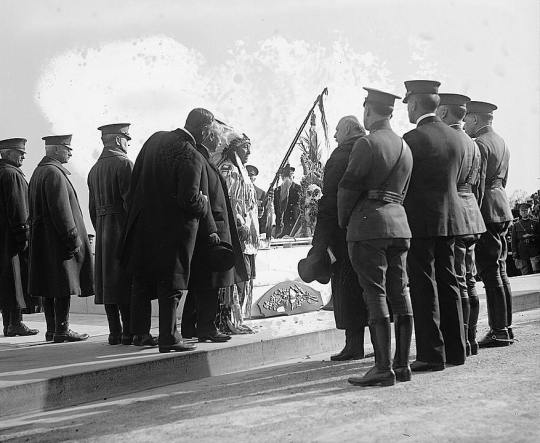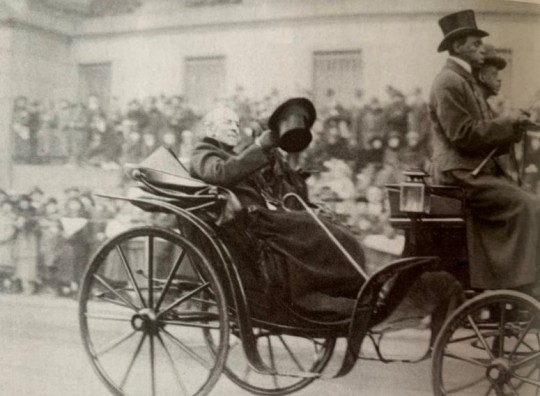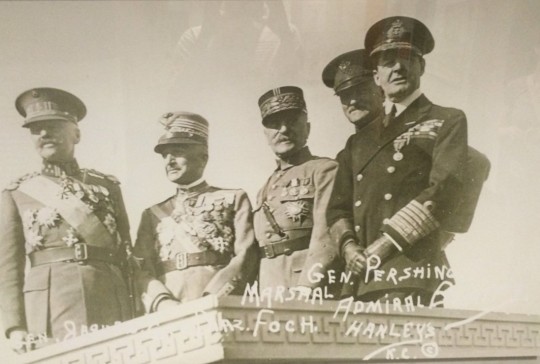#warren g harding

Chief Plenty Coups of the Crow Nation, pictured at the burial of the Unknown Soldier. The sarcophagus familiar to modern visitors was not completed until 1931.
November 11 1921, Arlington–On Armistice Day 1920, the United Kingdom and France had both buried unknown soldiers in places of honor–the former in Westminster Abbey, the latter under the Arc de Triomphe. In 1921, the United States followed suit. An unknown soldier was transported back across the Atlantic from France, where he laid in state in the Capitol rotunda for two days. On Armistice Day, the same day that the peace treaty with Germany would finally enter into effect, the casket was at the front of a procession down Pennsylvania Avenue as far as the White House, followed on foot by President Harding and General Pershing.

Wilson in a carriage at the end of the procession down Pennsylvania Avenue.
At the end of the procession were Woodrow and Edith Wilson in a rented carriage. The New York World wrote that the “pale face of the man who gave his health and strength to uphold the same ideals for which the Unknown Soldier died seemingly unleashed the pent-up emotions of the watchers.” Wilson did not continue on to Arlington, due to a combination of his health concerns preventing him from climbing the stairs at the amphitheater there, and Harding’s desire not to be upstaged by his predecessor.

General Jacques of Belgium, General Diaz of Italy, Marshal Foch of France, General Pershing of the United States, and Admiral Beatty of the United Kingdom, pictures at the dedication of the Liberty Memorial in Kansas City on November 1.
At the service in Arlington, President Harding gave a brief speech. He was followed by General Jacques of Belgium, Admiral Beatty (who presented the Unknown Soldier with the Victoria Cross), Marshal Foch, and General Diaz. The four military men were at the end of a tour of the United States, along with General Pershing, which also included the groundbreaking of the Liberty Memorial (now the National World War I Memorial) in Kansas City on November 1. Also in attendance were a large number of foreign civilian notables, among them Arthur Balfour and French PM Briand, who were in Washington for the start of the Washington Naval Conference on arms limitation the next day.
The burial service ended with a brief statement by Chief Plenty Coups of the Crow Nation, the sounding of “Taps” on a bugle, and a twenty-one gun salute.
Sources include: Patricia O’Toole, The Moralist (includes image credit for the picture of Wilson).
October 18 1921, Washington–Despite multiple attempts, the Treaty of Versailles had failed to reach the required two-thirds majority for ratification in the US Senate. The Harding Administration negotiated and signed new treaties with Germany, Austria, and Hungary, dropping American participation in the League of Nations or most other international commitments from Treaty of Versailles. Nonetheless, there was still determined opposition to the new treaties, and it was no means clear that the new treaties would not meet the same fate. Wilson, now living in DC, attempted to organize Democrats against the treaty, while a few die-hard irreconcilables opposed the treaty as they feared any recognition of any aspect of the Treaty of Versailles would lead to the United States joining the League of Nations in the future. Ultimately, however, the treaty with Germany was ratified by a wide margin, 66-20, with more than half of the Senate Democrats voting in favor. The other treaties were ratified by a similar margin. Wilson, fuming at this final defeat, called the treaty’s supporters “the most partisan, prejudiced, ignorant, and unpatriotic group that ever misled the Senate of the United States.”
August 25 1921, Berlin–Republican objections to the League of Nations had prevented American ratification of the Treaty of Versailles, and Harding’s election to the presidency in 1920 sealed its fate. This, however, left the United States still officially at war with Germany. On July 2, 1921 the United States officially declared that the state of war with Germany, Austria, and Hungary was over, but a formal peace treaty still needed to be signed. This came on August 25, with a brief treaty signed in Berlin. This effectively was the United States ratifying the Treaty of Versailles with extreme reservations:
- The United States would not join the League of Nations or the International Labour Organization.
- The United States would not concern itself with Germany’s borders or other strictly European matters agreed to in the treaty.
- The United States did not recognize the provisions of the Treaty of Versailles considering German concerns outside Europe (apart from the surrendering of her colonies); in particular, this included the handover of Shantung to the Japanese.
- The United States would not attempt to conduct war crimes trials of the Kaiser or other German war criminals.
- The United States would not join the International Labour Organization.
- The United States would not be compelled to participate in any commission called for by the Treaty of Versailles.
In the same week, similar treaties were signed with Austria and Hungary; the United States never declared war on Bulgaria or the Ottoman Empire.
Harding Wins in a Landslide

The 1920 Presidential Election results, with red for Republican Harding, and blue for Democrat Cox. Darker shades indicate states won by larger margins.
November 2 1920, Marion–Campaigning on a “return to normalcy” after the war, the Red Scare, the Red Summer, and economic upheaval, Republican Senator Warren G. Harding of Ohio won the presidential election on November 2 in a landslide of unprecedented scale. His 60.35% of the vote was the largest share of the vote won since the last uncontested election in 1820, and his 26.2% margin over Democrat James Cox is still the largest in a US presidential election. Cox only won Kentucky and 10 of the 11 states in the former Confederacy (Harding won Tennessee), the largest electoral college landslide since Reconstruction. Winning 3.41% of the vote (down from 5.99% in his 1912 run) was Socialist Eugene Debs, who ran his campaign from a prison cell. Harding’s popular vote total was over 75% larger than Wilson’s winning vote total four years earlier, a testament both to his landslide and the many new women voters enfranchised by the 19th Amendment.
Apart from usual Republican strongholds like Vermont, Harding’s win was biggest in the Upper Midwest: North Dakota, Minnesota, Iowa, Wisconsin, and Michigan all gave him over 70% of the vote. Hughes had won most of these states four years earlier, but he had won Minnesota by less than 400 votes and Wilson had won North Dakota. The war and Wilson’s handling of the German peace terms had apparently destroyed Democratic chances with German voters in the area. Wilson had hoped the campaign would be a referendum on the League, but Harding was noncommittal on the issue, and Cox eventually backed reservations on Article 10. On October 27, Wilson gave his first speech since his stroke, in support of the League, in front of an audience of 15 who still struggled to hear his words; he did not mention Cox at all. Wilson’s mishandling of the Senate had doomed the United States’ chance to enter the League long before, and Harding’s election heralded the United States’ general withdrawal from world affairs.
Sources include: Patricia O’Toole, The Moralist. Image credit: uselectionatlas.org
“Waiting for the President” (LOC) by The Library of Congress
Via Flickr:
“Waiting for the President” 1922 June 29. 1 photographic print. Notes: Photograph shows a girl in a broad brimmed hat seated on the White House steps with an umbrella and a Kodak Brownie camera by her side. Caption continues: Little Miss Tarkington, daughter of Mrs. W. Tarkington Jr., snaped (i.e., snapped) on the steps of the White House patiently waiting to snap a picture of Mr. Harding. In album: Washington, D.C., 1 June 1922 to 30 June 1922, v. 6, Herbert E. French, National Photo Company, p. 30, no. 19899. Forms part of: National Photo Company Collection (Library of Congress). Subjects: Cameras–1920-1930. Children–1920-1930. Photography–1920-1930. Format: Photographic prints–1920-1930. Rights Info: No known restrictions on publication. Repository: Library of Congress, Prints and Photographs Division, Washington, D.C. 20540 USA Higher resolution image is available (Persistent URL):hdl.loc.gov/loc.pnp/cph.3c31898Call Number: LOT 12294, v. 6 [item]
Following the death of President Warren G. Harding, it takes 14 advisers and his entire family to get Vice President Calvin “Silent Cal” Coolidge to finish the Oath of Office, after only saying two words and walking away.
Executive Order 3669, in which President Warren G. Harding establishes benefits for veterans after WWI, 4/29/1922
Series: Executive Orders, 1862 - 2016
Record Group 11: General Records of the United States Government, 1778 - 2006
Transcription:
[hand stamp, upper left corner of document] DEPT OF STATE APR 22 1922 DIVISION OF PUBLICATIONS
[hand stamp, upper right corner of document] CHIEF CLERK APR 29 1922 DEPARTMENT OF STATE
EXECUTIVE ORDER
WHEREAS, Section 9 of the Act of Congress entitled “An Act to Establish a Veterans’ Bureau and to improve the facilities and service of such Bureau, and further to amend and modify the War Risk Insurance Act”, approved August 9, 1921, provides that -
“Section 9. The director, subject to the general directions of the President, shall be responsible for the proper examination, medical care, treatment, hospitalization, dispensary and convalescent care, necessary and reasonable after care, welfare of, nursing, vocational training, and such other services as may be necessary in the carrying out of the provisions of this Act, and for that purpose is hereby authorized to utilize the now existing or future facilities of the United States Public Health Service, the War Department, the Navy Department, the Interior Department, the National Homes for Disabled Volunteer Soldiers, and such other governmental facilities as may be made available for the purposes set forth in this Act; and such governmental agencies are hereby authorized and directed to furnish such facilities, including personnel, equipment, medical, surgical, and hospital services and supplies as the director or may deem necessary and advisable in carrying out the provisions of this Act, in addition to such governmental facilities as are hereby made available *******”
AND WHEREAS said Section 9 further provides that:
“In the event that there is not sufficient Government Hospital and other facilities for the proper medical care and treatment of beneficiaries under this Act, and the director deems it necessary and advisable to secure additional Government facilities, he may, within the limits of appropriations made for carrying out the provisions of this paragraph, and with the approval of the President, improve or extend existing governmental facilities or acquire additional facilities by purchase or otherwise. Such new property and structures as may be so improved, extended, or acquired shall become part of the permanent equipment of the Veterans’ Bureau or of some one of the now existing agencies of the Government, including the War Department, Navy Department, Interior Department, Treasury Department, the National Homes for Disabled Volunteer Soldiers, in such a way as will best serve the present emergency, taking into consideration the future services to be rendered the veterans of the World War, including the beneficiaries under this Act.”
Post link


